Campus as a Living Lab
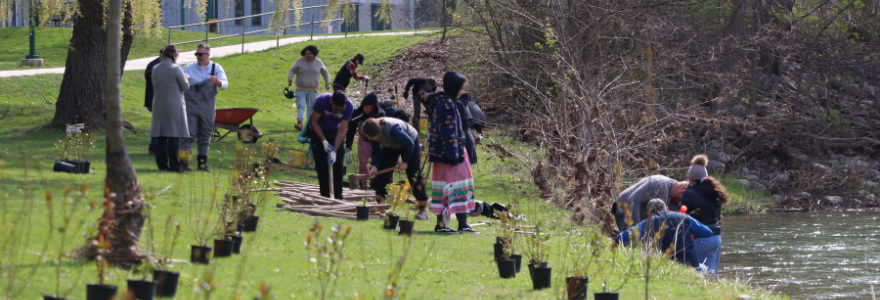
Western's Campus as a Living Lab program supports collaborations between academic leads and operational partners across Facilities Management and other departments. Living Lab projects support students, faculty and staff to learn from the lands, built environment, operations or experiences that make up our campus.
Projects are typically initiated by faculty and can involve teaching, research, or community service initiatives. Living Lab projects can take place anywhere within Western's main campus property boundary.
To get started, send us an email at sustainability@uwo.ca with your idea. We will then work together to define the collaboration and the roles of individuals or groups involved. We look forward to hearing from you!
Living Lab Projects
Bee Yard at Western University
The Bee Yard at Western University is led by Dr. Natasha Mhatre and Post Doctoral Fellow Sajesh Vijayan in the Departmemt of Biology and is located in a remote part of campus. The project will study dance communication in honeybee collectives. When honeybees leave an established colony and move on to another location, they gather in groups and communicate with each other using waggle dances. Bees sense these dances via the sounds and vibrations they make, but the message could get lost in the noise of the crowd. This project will investigate the technique the bees use to hear each other even in these busy and active groups.
Biodiversity Inventory at Western
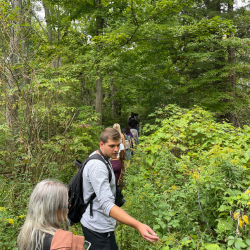 The Biodiversity Inventory at Western is led by an organizing committee of volunteers in the Faculty of Science with academic advisor Dr. Tim Hain. The project seeks to study the biodiversity that exists today on campus grounds. In the first year of the inventory project there were over 1,100 unique species identified on campus!
The Biodiversity Inventory at Western is led by an organizing committee of volunteers in the Faculty of Science with academic advisor Dr. Tim Hain. The project seeks to study the biodiversity that exists today on campus grounds. In the first year of the inventory project there were over 1,100 unique species identified on campus!
The project is now heading into its second year and all members of the campus community are invited to participate by contributing photos and other observations to community science using iNaturalist. Learn more about the project and how you can get involved on the Biodiversity Inventory website.
Combining physics-based models with AI and machine learning for building energy modelling
Combining physics-based models with AI and machine learning for building energy modelling is led by Dr. Kamran Siddiqui and Dr. Katarina Grolinger in the Faculty of Engineering. One way of modelling building energy consumption is by using physics-based models such as EnergyPlus. These models simulate the processes of building energy exchange to arrive at the estimates of energy consumption and associated costs, GHG emissions, and other parameters. Creating physic-based models requires information about building physical characteristics such as size and shape possibly from CAD drawings, isolation, roof type, equipment, occupancy, and many others. While not all details are necessary for creating such models, more detailed information leads to better models. Nevertheless, these models do not take into consideration how people use the building (behavioral patterns): it has been reported that this can lead to up to 2.5 times higher energy consumption.
In contrast, modelling based on AI and machine learning (ML), does not require detailed information about the building but takes advantage of past energy consumption data to create the energy model and estimate future energy consumption. While AL/ML models are excellent in predicting future energy consumption for existing buildings, they are not applicable for new buildings without historical consumption data and fail when major retrofits are introduced.
Therefore, this project aims to integrate physics-based models with AI/ML models to advance building energy modelling. By combining these systems, the project will enable improved energy models incorporating energy consumption patterns while also supporting the exploration of what-if scenarios for estimating consumption under changing conditions. Using Western buildings for this modelling will enable a better understanding of energy consumption in those buildings and create opportunities for improvements.
Community Field Course in Land Healing and Responsibility
This project is part of an Indigenous Studies/Geography course "IS4023/GEO3001F; A Field Course in Land Healing and Responsibility" co-taught by Dr. Desmond Moser and Clint Jacobs and is supported by a 2021 Indigenous Learning Fund grant from Western's Office of Indigenous Initiatives.
The project will engage in passive (observational) and active (land modification) types of academic engagement. Observational work will focus on mapping and monitoring the state and seasonable variations of the site including vegetation, soil types, insect populations, animal, reptile, and bird identification, and acoustics (soundscapes). Active land modification will be small-scale and iterative, varying according to what is learned from mapping and monitoring. The overarching aim will be to re-establish native vegetation with an emphasis on pollinator-friendly species, improve habitat for species at risk, and communicate the nature and purpose of these activities, and their value, to the community. Through such learning and land-healing activities it is hoped that students will develop connections and responsibility to land.
Commuting to Campus: Exploring Transportation Choices in a Time of Climate Crisis
Led by Blair Kingdon for their masters thesis and supervised by Dr. Andrew Walsh, this thesis research will investigate the transportation choices of students, faculty and staff to determine how poorly understood factors influence Canadian transportation norms in the face of climate change. Despite technical and educational attempts across Canada to reduce hyperautomobility, most Canadians have yet to adopt sustainable transportation habits.
In broad terms, this research seeks to understand factors that influence, enable, and impede the transformation of climate concern into climate action.
Development of a Campus-Level Urban Scanning Framework
Led by Dr. Ayan Sadhu (PI), this project is about development of a city-level urban scanning framework for tracking infrastructure and environmental status. The first phase of the project developed a sensing technology that was mounted on a vehicle to scan the pavement and environmental conditions such as temperature, humidity, air pollution and snow.
Building on the lab- and campus-scale development of the urban scanning framework, the next phase focuses on enhancing environmental sensing through the integration of an IoT-based snow level measurement system. The team will design and deploy ultrasonic snow sensors to monitor accumulation on roadways and adjacent surfaces, with seamless integration into the existing sensing network. In parallel, the cloud-based dashboard will be updated and expanded to visualize snow and related environmental data, supporting real-time monitoring of winter conditions. Together, these enhancements aim to inform on-campus maintenance interventions while contributing to a scalable, mobile sensing platform for tracking infrastructure and environmental variables critical to urban resilience.
Digital Twins with Machine Learning for a Sustainable Future
Led by Dr. Katarina Grolinger (PI), Dr. Miriam Capretz (Co-PI) and Dr. Girma Bitsuamlak (Co-PI), this project is about optimizing building performance through technologies such as digital twins, artificial intelligence (AI), and Internet of Things (IoT). Digital Twin is a living digital model of a building that continually evolves alongside the real-world building based on real-time data from sensing/IoT systems. IoT with machine learning (ML) enables insights into building dynamics and establishes a platform for learning about how people use buildings. Additionally, simulations enable studying building energy use under varied conditions. Building Information Modelling (BIM) provides high-fidelity information about the building physical infrastructure; but not the real-time operation of buildings.
The main objective of this project is to design and develop digital twin models that extend BIM systems and reflect the dynamic nature of the buildings through real-time IoT systems, learn from IoT and other data employing ML/AI, simulate building use scenarios, and ultimately support net-zero targets.
Distribution and effects of soil macrofauna along forest to field gradients
This project is led by Dr. Robert Buchkowski in the Department of Biology. This study explores how soil macrofauna — such as insects, earthworms, and other invertebrates — influence decomposition and nutrient cycling across the transition from forest to field. This research focuses on forest edges, which can create unique conditions that support diverse soil communities with important effects on ecosystem processes.
Several transects will be set up at each site, stretching up to 50 metres into both the forest and the field, with marked sampling locations for repeated monitoring. Field methods include collecting soil samples, pitfall trapping to survey surface-active organisms, extracting earthworms using non-invasive mustard solutions, deploying bait lamina and root simulator strips, and conducting vegetation surveys to connect soil and plant data.
This work will help reveal how transitional habitats like forest edges contribute to biodiversity and nutrient cycling in ways that are often overlooked.
Expanding the "Keep it on Campus" campaign to internal manufacturing and recycling
Led by Dr. Joshua Pearce, this project aims to expand the Keep it on Campus concept to internal manufacturing and recycling. The Free Appropriate Sustainable Technology (FAST) Lab will act as a demonstration site using their advanced manufacturing facilities and recycling experience to provide both sustainability and economic benefits.
With support from Procurement Services the FAST Lab will analyze products that can be manufactured on campus for the campus community. The goal is to utilize campus waste directly in the manufacturing for increased economic and sustainable impact.
FOGs Pollinator Garden
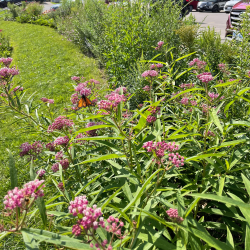 The FOGs Pollinator Garden is led by Friends of the Gardens (FOGs) volunteers representing students, staff and faculty from a cross-section of campus departments along with academic advisors Dr. Greg Thorn and Dr. Graham Thompson.
The FOGs Pollinator Garden is led by Friends of the Gardens (FOGs) volunteers representing students, staff and faculty from a cross-section of campus departments along with academic advisors Dr. Greg Thorn and Dr. Graham Thompson.
Since 1995, FOGs volunteers have been taking care of the St. Mary's Cement Rock Garden, located southeast of the Biology and Geological Sciences Building on campus. In 2022 FOGs implemented the first Pollinator Garden on campus with support from Facilities Management.
The garden is located in Middlesex Parking Lot, behind Middlesex College. Be sure to take a visit and see many types of pollinators throughout the season!
Anyone interested in starting their own pollinator garden supportive of native biodiversity is encouraged to utilize this Pollinator Garden Plant List which provides important information such as the scientific names and native status of all the plants currently in the Pollinator Garden.
Invasive Species Management: Buckthorn removal in the Huron Fields
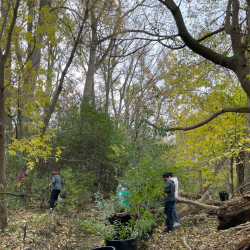 This project, led by Dr. Paul Mensink, engages students in the Masters of Environment and Sustainability (MES) program in the management of buckthorn on campus, in collaboration with Landscape Services. Buckthorn is an invasive species that poses severe threats to local ecosystems by outcompeting native plants, disrupting wildlife habitats, and altering soil chemistry.
This project, led by Dr. Paul Mensink, engages students in the Masters of Environment and Sustainability (MES) program in the management of buckthorn on campus, in collaboration with Landscape Services. Buckthorn is an invasive species that poses severe threats to local ecosystems by outcompeting native plants, disrupting wildlife habitats, and altering soil chemistry.
To address these issues, this project is a systemic initiative to document buckthorn's spread around campus, placing special emphasis on areas where buckthorn is predominant to ensure prompt action. It is an invaluable hands-on experience for MES students, tasking them with data collection, species identification, and the physical removal of buckthorn in the area. This work aims to rejuvenate the university's native woodland ecosystem and also enrich our students' educational experience.
Software Engineering Lab - 5G Empowered Predictive Maintenance
This project, led by Dr. Miriam Capretz through the Software Engineering Lab at Western Engineering, is a collaboration with Western's Power Plant for a data-driven predictive maintenance model. Predictive Maintenance (PdM) is set to detect early symptoms that may cause defects in assets. Visual inspections and sensor information are crucial in comprehensively identifying and predicting abnormal operations and equipment downtimes within the PdM paradigm. The research aims to develop a Data-Driven Predictive Maintenance Framework to monitor assets and generate information that can help guide decision-making on critical assets' maintenance activities and useful life. Therefore, real-time images, data from sensors regarding the assets' operation, and machine learning-based reasoning can help substitute human inspection.
Solar Powered Picnic Table
Led by Dr. Joshua Pearce in the Department of Electrical & Computer Engineering, this project will develop and deploy solar-powered charging station picnic tables using a combination of technologies that Dr. Pearce's team and partners have developed. Imagine sitting at a picnic table and charging your laptop, cellphone, and even an e-bike using solar power.
The solar picnic table utilizes an innovative solar panel which can be designed to blend into other materials. It will look like a regular picnic table, and will demonstrate that solar can now look like anything. Adding to the sustainability of this project, the table will be made from waste plastic composites that will last for decades. The entire tabletop will be a solar panel in disguise with a DC nanogrid developed by Western students. A prototype will be built and installed for testing close to the engineering corridor of campus. Over time the design will be refined and potentially scaled up in more central locations on campus.
Sustainable Resource Management - nutrients in urban agriculture
Led by Dr. Geneviève Metson in the Department of Geography and Environment, this is a multi-year living lab community garden which will be its own hydrological catchment so that multiple environmental parameters, most notably nutrient losses via runoff, erosion, and leaching, can be monitored. Monitoring happens year-round to document how nutrient losses vary seasonally under a changing climate.
The living lab contributes to the Sustainable Resource Management lab's overarching long-term goal to advance understanding of anthropogenic phosphorous and nitrogen cycling so that communities can enact management practices that support food security and improve water quality in a rapidly changing world.
Another element of this project includes the installation of a unique outdoor mural on the fencing surrounding the SRM Community Garden. The mural is designed to enhance the garden space and reflect the project's community and environmental values.
Wampum Learning Lodge Medicine Garden
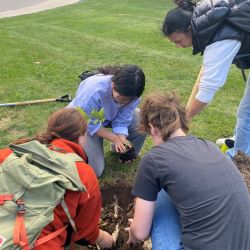 This project is led by Dr. Cortney Golkar-Dakin as instructor of the Geography and Environment / Indigenous Studies course GEOG 9123A / IS 4142F Decolonizing Land-Based Relations. It is also a collaborative initiative with The White Corn Revitalization Project and the Office of Indigenous Initiatives at the Wampum Learning Lodge and is supported by the 2024 Indigenous Land-based Learning Fund.
This project is led by Dr. Cortney Golkar-Dakin as instructor of the Geography and Environment / Indigenous Studies course GEOG 9123A / IS 4142F Decolonizing Land-Based Relations. It is also a collaborative initiative with The White Corn Revitalization Project and the Office of Indigenous Initiatives at the Wampum Learning Lodge and is supported by the 2024 Indigenous Land-based Learning Fund.
The project will engage students in field assignments that involve deep introspection and the embodiment of principles of decolonial theory/praxis during their field activities in the garden. Students' project tasks will vary based on their research interests and feedback from the Wampum Learning Lodge and The White Corn Project collaborators. The main objectives of the project will be to find creative ways to support and diversify native species in the garden, promote pollinator plants, apply Indigenous ways of knowing, provide for species' habitat, and/or mitigate the impact of invasive species. Students will be able to communicate the nature, purpose, and significance of their field work, as well as develop strategies for decolonization that are based on reciprocal relationships with the land.
Completed Projects
Barn Swallow Breeding and Nesting Structure
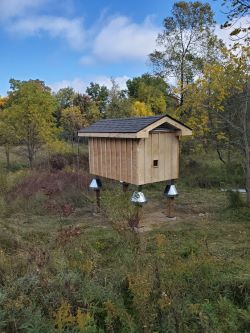 The Barn Swallow Structure was constructed Fall 2022 with the leadership of a Biology PhD student, academic advisor Dr. Scott MacDougall-Shackleton, and support from WWF-Canada, University Students' Council, the Society of Graduate Students, the Advanced Facility for Avian Research, and Bird Friendly London/Nature London.
The Barn Swallow Structure was constructed Fall 2022 with the leadership of a Biology PhD student, academic advisor Dr. Scott MacDougall-Shackleton, and support from WWF-Canada, University Students' Council, the Society of Graduate Students, the Advanced Facility for Avian Research, and Bird Friendly London/Nature London.
Barn Swallows are a bird Species at Risk in Ontario whose numbers have declined in recent years, partly due to habitat loss. These birds rely on specific types of structures (like barns) to host their nests. Barn Swallows occur in high abundance at Western because of the habitat available here including wetlands, grasslands, old growth forest and the Medway Valley Heritage Forest ESA. Each year many Barn Swallows return to campus and construct nests on buildings adjacent to these natural features; which can put the birds in conflict with high-pedestrian traffic and maintenance work, reducing their breeding success.
The Barn Swallow Structure provides an alternate location for Barn Swallows to breed on campus, in a low-traffic location with natural features they need to survive (e.g. insects, mud). The structure was built in a naturalized part of campus to increase breeding success for the birds; if you do come across the structure, please do not approach too closely to respect the birds' space. In future this project will monitor Barn Swallows' usage of the structure, breeding success, and effectiveness of the construction features of this structure to help inform best practices on effective design standards for Barn Swallow Breeding Structures.
Case Study: Ecosystem Management (BIO 3222G)
This project runs during winter semester as a case study project for students in the course BIO 3222G with Dr. Rob Buchkowski.
Students will analyze existing data on university lands such as the Baldwin Flats, Fram Lands, and the Environmental Sciences Western Field Station. Using site information available online and provided by Facilities Management, as well as in-person site visits, students in the class will develop short management plans recommending interventions relevant to meeting specified goals such as restoration, conservation, carbon storage, etc.
Collaboration and Connectedness in a Community Garden
This study, led by Dr. Lesley Gittings with student co-investigators from the Faculty of Health Sciences, will focus on the campus community garden with a primary method of interviewing both past and present community garden participants.
Our research goal is to delve into the perceptions and experiences of individuals concerning the campus-based community garden. By understanding factors that drive or deter their involvement, we aim to illuminate the influence of the garden on their connection to nature, efficacy in sparking positive change, and overall well-being. Moreover, we will uncover benefits of participating in a community garden, including improved food security, heightened environmental awareness, and enhanced emotional well-being. In essence, we're exploring the campus community garden as a multi-dimensional, nature-based health intervention that holds potential benefits for both individuals and the broader environment.
Community Garden Art Installation
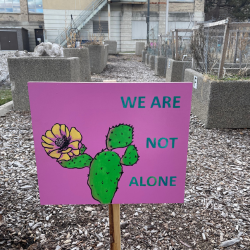 The Community Garden Art Installation project was completed as a class project in Dr. Amanda White's course Visualizing Foodways: Art+Food Relational Approaches. Students in the course were inspired by suggestions presented in their course reading, How to grow liveable worlds: Ten (not-so-easy) steps for life in the Planthroposcene by anthropology scholar Natasha Myers. Signage around the Community Garden adds brightness during the grey winter days with the hope of prompting Western community members to consider their relationships with food and the land.
The Community Garden Art Installation project was completed as a class project in Dr. Amanda White's course Visualizing Foodways: Art+Food Relational Approaches. Students in the course were inspired by suggestions presented in their course reading, How to grow liveable worlds: Ten (not-so-easy) steps for life in the Planthroposcene by anthropology scholar Natasha Myers. Signage around the Community Garden adds brightness during the grey winter days with the hope of prompting Western community members to consider their relationships with food and the land.
The class included a mix of undergraduate and graduate students who collaborated on the ideation and implementation of the art installation at the garden. In addition to the physical signage, the students also created a participatory webpage about the project. Along with their experience and intentions with the project, they also present featured food plant submissions from the campus community with stories about the significance of the food plants.
Environmental and corrosion effects of road de-icing salts
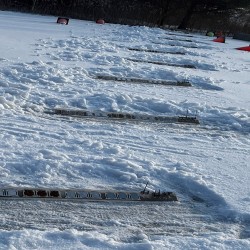 Led by Dr. Yolanda Hedberg and Dr. Christopher Power, this living lab was part of a larger project led by the principal investigators in collaboration with an industry partner (Cypher Environmental Ltd.). The research provides a comprehensive assessment of both traditional and newer road de-icing salts in terms of their ice-melting performance, and environmental and corrosion effects. The 2-year project (July 2022 to June 2024) was funded through a joint NSERC Alliance-Mitacs Accelerate research grant.
Led by Dr. Yolanda Hedberg and Dr. Christopher Power, this living lab was part of a larger project led by the principal investigators in collaboration with an industry partner (Cypher Environmental Ltd.). The research provides a comprehensive assessment of both traditional and newer road de-icing salts in terms of their ice-melting performance, and environmental and corrosion effects. The 2-year project (July 2022 to June 2024) was funded through a joint NSERC Alliance-Mitacs Accelerate research grant.
Exploring Challenges and Opportunities for Sustainable Practices: Perceptions and Behaviours of Students and Staff Towards Food Waste at Western University
This study is led by Dr. Lesley Gittings with student co-investigators, Lana Mamika and Sairah Khan with the Faculty of Health Sciences. This study aims to explore and document the perceptions and behaviours of first-year students living in residence and Hospitality Services staff members related to food waste on campus through in-depth semi-structured interviews.
By understanding these perceptions, this research project seeks to identify the drivers of food waste in residences, the challenges in implementing food waste programs, and the potential impact of these programs on health and well-being. Moreover, as a community-engaged initiative, this research aligns with Western University's goals to advance sustainability and foster an environmentally friendly community on campus that empowers the health and well-being of staff and students. The research will provide evidence-based recommendations to enhance food waste reduction efforts
Improved multi-scale GHG emissions modelling from urban environments to enhance mitigation strategies
This project was led by Dr. Kamran Siddiqui (Department of Mechanical and Materials Engineering) and Dr. Jamie Voogt (Department of Geography and Environment). The initiatives of this project are part of a multi-million dollar project at Western called "Improved multi-scale greenhouse gas emissions modelling from urban environments to enhance mitigation strategies" that has received funding from Environment and Climate Change Canada (ECCC) through the Climate Action and Awareness Fund (CAAF).
As part of the CAAF, Western building performance metrics were analyzed for improving building modelling. The CAAF researchers are developing the comprehensive urban physics model: Vertical City Weather Generator (VCWG) model which requires ground truth "building performance data" for its validation, parameterization, and refinement.
The second part of this project involved monitoring the PV solar array on Amit Chakma Engineering Building and the roof's microclimate for building energy model evaluation. The CAAF project is looking at the impacts of green roofs and PV array roofs on both the atmosphere above and building below. The ACEB provides a campus example of a building equipped with PV array that can provide a good test case for evaluating numerical models.
Investigation of migratory behaviour in North American hoverflies (Syrphidae)
This research project is led by a team in the Department of Biology with academic advisors Jackson Kusack and Dr. Keith Hobson. Hoverflies are important pollinators across all ecosystems in North America. They also provide pest control as the larval stage of some species predate aphids, thrips, and other pest insects. Despite their importance, very little is known about the movements of hoverflies in North America, outside of anecdotal information. This project is investigating migratory vs. locally emergent origin for five species of hoverflies that show evidence of seasonal range potentially indicative of migratory movements.
Live Stake Planting for Climate Resiliency
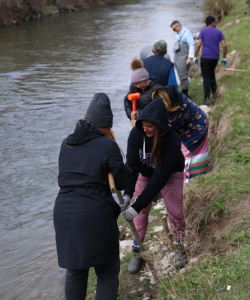 This project is led by a team of students with interdisciplinary faculty support and academic advisors Dr. Tom Cull and Dr. Sandra Smeltzer alongside community partner, Upper Thames River Conservation Authority (UTRCA). It is also funded by a Thinking Globally Acting Locally grant.
This project is led by a team of students with interdisciplinary faculty support and academic advisors Dr. Tom Cull and Dr. Sandra Smeltzer alongside community partner, Upper Thames River Conservation Authority (UTRCA). It is also funded by a Thinking Globally Acting Locally grant.
Climate change continues to increase severe weather, including flooding. The Thames River (Deshkan Ziibi) connects the City of London and Western University with nearby First Nations: Chippewas of the Thames First Nation, Munsee-Delaware Nation and Oneida Nation of the Thames. The resilience of this river and watershed affects all of us. This project aims to improve the ecological health of the river, mitigate increased flooding risk, and build relationships with communities within the river watershed. This will be done by planting native trees and shrubs to increase ecological health, help mitigate against future flooding, and educational initiatives both locally and globally on this type of river restoration.
A simple bioengineering technique that is often practiced for riparian restoration projects is called live stake planting, in which cuttings are taken from live trees, pruned of branches, sharpened at the base and inserted into the soil along waterways at sufficient depths for roots to reach groundwater. This project planted about 75 native tree live stakes along Medway Creek behind Westminster Hall in an area prone to flooding. Further from the water's edge around 200 native shrubs were planted, adding to the ecological health of the river environment and flood mitigation.
Learn more about this project on the UTRCA website.
Maple Syruping for Biology 2217B
This project is led by Dr. Ben Rubin to demonstrate the process of making maple syrup in the course lab for his Biology 2217B class. The project includes tapping a few select trees on campus to collect sap. Sap will be brought to the course lab to make into maple syrup with the class.
Pheromone Traps for Collection of Brown Marmorated Stink Bug
This project, led by Dr. Brent Sinclair, and PhD student Mikaelison Lima, studies the Brown Marmorated Stink Bug [(BMSB), Halyomorpha halys, (Hemiptera: Pentatomidae)], an invasive species of true bug originating from southeast Asia. It is a polyphagous insect pest of high economic importance in North America as it is a pest of a wide variety of fruits and vegetables, such as tomatoes, apples, peaches, peppers, beans, and corn (Xu et al. 2013; Rice et al. 2014; Haye et al. 2015). This project aims to set up pheromone traps on campus to collect BMSB throughout the spring, summer, and fall. The insects will be collected for colony establishment in the laboratory.
Uncovering the stories that corrosion products can tell about environmental pollution
This project is led by Dr. Yolanda Hedberg, Department of Chemistry with Cadence Harrison, Head and Heart Fellow, to investigate whether corrosion products can be used to understand historical pollution levels. The research team received a donation of corroded parts from a small construction company in the Sarnia chemical valley, with a history of environmental pollution due to nearby petrochemical industries. Western's electromechanical shop also provided a corroded part from an aging vehicle that has mainly been used on campus as a reference point. The research will determine whether it is possible to analyze corrosion products from one area to understand its historical pollution levels.

